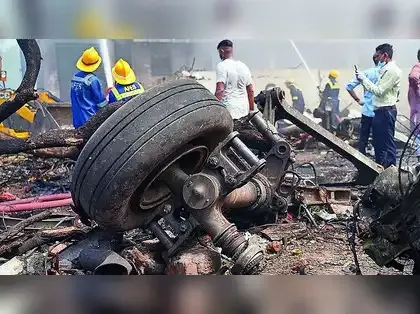The sole purpose of states devoting resources to investigate an air accident is to determine the cause and take corrective action to prevent a recurrence. What such an investigation absolutely shouldn't do is apportion or indicate blame on anyone.
What investigators in the AI 171 crash have managed to do with the preliminary report that was released on Saturday is exactly opposite of that. It has left the airlines and regulators wondering what should be done to prevent another air tragedy, while hinting at casting aspersions on capability or mental health of pilots.
International Civil Aviation Organization (ICAO) recommends that in cases of heightened public attention, the state investigating the case should publish the report within 30 days. It should lay down all facts obtained during the early stages of the investigation and provide safety recommendations if it deems fit at that stage. Aircraft Accident Investigation Bureau (AAIB) has done remarkably well to meet this deadline. But a bare reading of the report reflects it trying to hide more than providing information. Initial reports of investigations into similar crashes present a transcript of the cockpit voice recorder (CVR) along with timestamps.
For instance, while releasing the early report into the investigation of the accidents involving Boeing 737 Max aircraft, Indonesian and Ethiopian authorities laid out the entire transcript of the CVR. It depicted the pilots' struggle to regain control of the plane despite performing all procedures mandated by the manufacturer. Airlines and regulators across the world look to such cues to take preventive action so as to cut down any factors that can risk flight safety.
Absence of such details in AAIB's report - while cherry-picking a single sentence in which one pilot is heard asking the other regarding why he had cut off the fuel switch, to which the reply was that he hadn't - is questionable. It has led to pointless speculation on pilot error, or worse, pilot suicide, since these switches in crafts like the 787 have safeguards like metal lock and a guard built around them to avoid any accidental 'switching off'.
By keeping the report open-ended, AAIB has provided fertile ground for claims and counter-claims that can affect pilots at large. Further, it gives no further details on what happened in the 10 secs between the switches being cut off and being put on again. Surely, sharing such details wouldn't have harmed the probe process. Instead, it would have helped to understand why investigators believe they see no risk with either the Boeing 787 aircraft or GE engines.
The report also cites a 2018 advisory of Federal Aviation Administration (FAA), which flagged the possibility of disengagement of the fuel switch-locking mechanism, although in a different type of aircraft. Because the bulletin was advisory and the issue was not deemed an unsafe condition, it stated that Air India did not conduct inspections on its fleet. It raises the suspicion about whether the crash was due to bad engineering practice. But in the very next sentence, the report states that Air India replaced the throttle control module twice, in 2019 and 2023.
In a modern-generation jet like Boeing 787, the thrust control module and fuel control switches are physically integrated into the same unit, and replacing the module also involves replacing fuel switches. If at all investigators felt that it was a significant fact in the accident, the least they could have done is advise airlines to check the locking mechanism of the switches.
The crux of ensuring success of a process is to maintain public trust. The report has managed to break that trust with some claiming it's hiding pilot error, intentional or not. From the very start, the investigation process has been shrouded with controversy with AAIB or civil aviation ministry deciding not to give any update. It is essential to effectively communicate in today's 'real-time information' era. In the absence of that, it's misinformation that fills the void.
What investigators in the AI 171 crash have managed to do with the preliminary report that was released on Saturday is exactly opposite of that. It has left the airlines and regulators wondering what should be done to prevent another air tragedy, while hinting at casting aspersions on capability or mental health of pilots.
International Civil Aviation Organization (ICAO) recommends that in cases of heightened public attention, the state investigating the case should publish the report within 30 days. It should lay down all facts obtained during the early stages of the investigation and provide safety recommendations if it deems fit at that stage. Aircraft Accident Investigation Bureau (AAIB) has done remarkably well to meet this deadline. But a bare reading of the report reflects it trying to hide more than providing information. Initial reports of investigations into similar crashes present a transcript of the cockpit voice recorder (CVR) along with timestamps.
For instance, while releasing the early report into the investigation of the accidents involving Boeing 737 Max aircraft, Indonesian and Ethiopian authorities laid out the entire transcript of the CVR. It depicted the pilots' struggle to regain control of the plane despite performing all procedures mandated by the manufacturer. Airlines and regulators across the world look to such cues to take preventive action so as to cut down any factors that can risk flight safety.
Absence of such details in AAIB's report - while cherry-picking a single sentence in which one pilot is heard asking the other regarding why he had cut off the fuel switch, to which the reply was that he hadn't - is questionable. It has led to pointless speculation on pilot error, or worse, pilot suicide, since these switches in crafts like the 787 have safeguards like metal lock and a guard built around them to avoid any accidental 'switching off'.
By keeping the report open-ended, AAIB has provided fertile ground for claims and counter-claims that can affect pilots at large. Further, it gives no further details on what happened in the 10 secs between the switches being cut off and being put on again. Surely, sharing such details wouldn't have harmed the probe process. Instead, it would have helped to understand why investigators believe they see no risk with either the Boeing 787 aircraft or GE engines.
The report also cites a 2018 advisory of Federal Aviation Administration (FAA), which flagged the possibility of disengagement of the fuel switch-locking mechanism, although in a different type of aircraft. Because the bulletin was advisory and the issue was not deemed an unsafe condition, it stated that Air India did not conduct inspections on its fleet. It raises the suspicion about whether the crash was due to bad engineering practice. But in the very next sentence, the report states that Air India replaced the throttle control module twice, in 2019 and 2023.
In a modern-generation jet like Boeing 787, the thrust control module and fuel control switches are physically integrated into the same unit, and replacing the module also involves replacing fuel switches. If at all investigators felt that it was a significant fact in the accident, the least they could have done is advise airlines to check the locking mechanism of the switches.
The crux of ensuring success of a process is to maintain public trust. The report has managed to break that trust with some claiming it's hiding pilot error, intentional or not. From the very start, the investigation process has been shrouded with controversy with AAIB or civil aviation ministry deciding not to give any update. It is essential to effectively communicate in today's 'real-time information' era. In the absence of that, it's misinformation that fills the void.
(Disclaimer: The opinions expressed in this column are that of the writer. The facts and opinions expressed here do not reflect the views of www.economictimes.com.)






Arindam Majumder